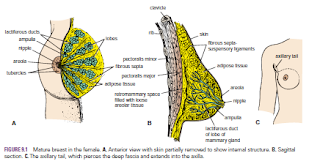The
Breasts
The breasts, they are situated in the pectoral region so
they are not anatomically part of the upper limb and their blood supply and
lymphatic drainage is largely into the armpit. Their clinical importance cannot
be overemphasized.
The breasts are specialized accessory glands of the skin
that secrete milk. They are present in both sexes. In males and immature
females, they are similar in structure. The nipples are small and surrounded by
a colored area of skin called the areola. The breast tissue consists of a
system of ducts embedded in connective tissue that does not extend beyond the
margin of the areola.
Puberty
At puberty in females, the breasts gradually enlarge and assume
their hemispherical shape under the influence of the ovarian hormones. The
ducts elongate, but the increased size of the glands is mainly from the
deposition of fat. The base of the breast extends from the 2nd to 6th rib and
from the lateral margin of the sternum to the midaxillary line. The greater
part of the gland lies in the superficial fascia. A small part, called the
axillary tail, extends upward and laterally, pierces the deep fascia at the
lower border of the pectoralis major muscle, and enters the axilla.
Each breast consists of 15 to 20 lobes, which radiate out from
the nipple. The main duct from each lobe opens separately on the summit of the
nipple and possesses a dilated ampulla just before its termination. The base of
the nipple is surrounded by the areola. Tiny tubercles on the areola are
produced by the underlying areolar glands.
The lobes of the gland are separated by fibrous septa that
serve as suspensory ligaments. Behind the breasts is a space filled by loose
connective tissue called the retromammary space.
Young
Women
In young women, the breasts tend to protrude forward from a
circular base.
Pregnancy
Early In the early months of pregnancy, there is a rapid increase
in length and branching in the duct system. The secretory alveoli develop at
the ends of the smaller ducts, and the connective tissue becomes filled with expanding
and budding secretory alveoli. The vascularity of the connective tissue also
increases to provide adequate nourishment for the developing gland. The nipple
enlarges, and the areola becomes darker and more extensive as a result of
increased deposits of melanin pigment in the epidermis. The areolar glands
enlarge and become more active.
Late During the second half of pregnancy, the growth process
slows. The breasts, however, continue to enlarge, mostly because of the
distention of the secretory alveoli with the fluid secretion called colostrum. Postweaning
Once the baby has been weaned, the breasts return to their inactive state. The
remaining milk is absorbed, the secretory alveoli shrink, and most of them
disappear. The interlobular connective tissue thickens. The breasts and the
nipples shrink and return nearly to their original size. The pigmentation of
the areola fades, but the area never lightens to its original color.
Postmenopause
After the menopause, the breast atrophies. Most of the
secretory alveoli disappear, leaving behind the ducts. The amount of adipose
tissue may increase or decrease. The breasts tend to shrink in size and become
more pendulous. The atrophy after menopause is caused by the absence of ovarian
estrogens and progesterone
Blood
Supply
Arteries
The branches to the breasts include the perforating branches
of the internal thoracic artery and the intercostal arteries. The axillary
artery also supplies the gland via its lateral thoracic and thoracoacromial
branches.
Veins
The veins correspond to the arteries.
Lymph Drainage
The lymph drainage of the mammary gland is of great clinical
importance because of the frequent development of cancer in the gland and the
subsequent dissemination of the malignant cells along the lymph vessels to the
lymph nodes.
The lateral quadrants of the breast drain into the anterior axillary
or pectoral group of nodes (situated just posterior to the lower border of the
pectoralis major muscle). The medial quadrants drain by means of vessels that
pierce the intercostal spaces and enter the internal thoracic group of nodes
(situated within the thoracic cavity along the course of the internal thoracic
artery). A few lymph vessels follow the posterior intercostal arteries and drain
posteriorly into the posterior intercostal nodes (situated along the course of
the posterior intercostal arteries); some vessels communicate with the lymph
vessels of the opposite breast and with those of the anterior abdominal wall.


No comments:
Post a Comment